Saving Heirloom Seeds and Taking back the Power from Monopolies
US farmers who buy genetically modified (GM) seeds are not allowed to save the seed,or give it to a neighbor. These GM seeds have now been patented and force the farmer to buy new seed every planting season. It is illegal to save GM seeds and these companies employ the "Seed Police" to spy on farmers to make sure that they are towing the line. If not, they are either leaned on heavily and threatened with legal action, or actually sued for non-compliance and breaking their signed contract that is drawn-up between the company and the farmer when the GM seed is purchased.
In addition, it appears that seed companies are lucrative business for those wanting to create monopolies and have attracted the investment of corporations such as Shell, ICI, Ciba Geigy and Volvo worth more than $50 billion in worldwide seed trade.
In addition, the company, Monsanto, responsible for Genetically Modified seeds in the USA as well as the production of Roundup, a worldwide herbicide that has been linked to birth defects and non-Hodgkin's Lymphoma and environmental pollution, has bought one of the biggest seed companies in the States, Seminis, Inc.
" It is estimated that Seminis controls 40 percent of the U.S. vegetable seed market and 20 percent of the world market—supplying the genetics for 55 percent of the lettuce on U.S. supermarket shelves, 75 percent of the tomatoes, and 85 percent of the peppers, with strong holdings in beans, cucumbers, squash, melons, broccoli, cabbage, spinach and peas. The company’s biggest revenue source comes from tomato and peppers seeds, followed by cucumbers and beans."
See: www.seedalliance.org/Seed_News/SeminisMonsanto/
See: http://www.vanityfair.com/politics/features/2008/05/monsanto200805
It is time to take back the power. Companies should not have a monopoly on our food sources like this. By growing open-pollinating seeds, and buy saving your seeds you are taking back control of your food and ensuring that your vegetables are GM free.
Favorite heirloom seeds, used for generations that were enjoyed because they were easy to grow, or tasted great are becoming no longer available. Instead seeds are replaced because they travel well, don't ripen too quickly or have a harder skin and don't bruise on transit. The fact that they taste like blotting paper doesn't matter.
People throughout the world are fighting back and forming networks of people who are determined to save the open-pollinated heirloom seeds and swap them among themselves. This is where we come in. We have over 100,000 people who visit this website every month - and the number grows each month. If we had just 10% of that number willing to save and swap heirloom seeds what a wonderful cyber community we could be to take back some control of our lives from Nanny States and organizations who try and manipulate how we live our lives, and swap and exchange with like-minded others to save our plant genetic diversity.
Since the time man first became a farmer he as saved seeds from his own vegetable crops. Until late 19th century, commercial seeds were rare and expensive. The Shakers were the first to sell seeds in plain packets.However, now seeds are sold commercially, and commercial seeds today are treated with anti-fungal chemicals and dyed bright pink, green, orange etc. as you can see from the picture below.
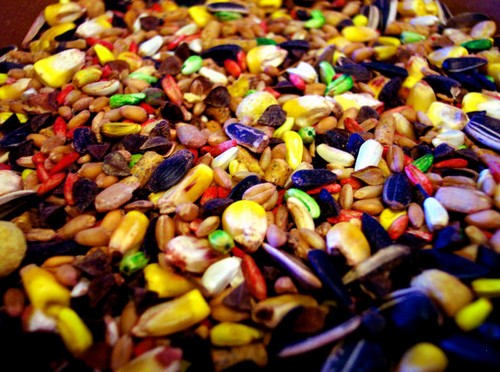
Chemically Treated Commercial Seeds
How do Plants Make Seeds
Seeds form after your flowers or vegetables have produced flowers. If your plants are annuals they will flower every year and seeds will follow. Radishes and spinach for example are both annuals so you will be able to harvest the seed every year from such plants. Root vegetables, however, are usually binennials which means that they will produce seeds only in the second year.Carrots are an example of a biennial vegetable. It will spend the first year putting down roots, and thereby making carrots for you. The second year the plants will produce long stalks with flowers and seeds will follow. You cannot eat the carrots in the second year because all the goodness has not stopped being stored in the roots, which are now hard and woody, and instead all concentration of goodness has gone into producing the flowers and the seeds.
There are other plants that are happy self-seeders. These are plants that will happily grow again if you have missed a vegetable in the garden the previous season, or it drops its seed so readily that it comes up year after year, after year. Radishes, spinach, sunflowers, tomatoes are just plants.
Open Pollinated versus Hybrid Seeds
Your heirloom seeds are those that are the open-pollinated variety, as already mentioned. Hybrid seeds will not breed true if you plant the seeds again the following year. Another words, you will get some produce from your seeds but they will be no where near the same standard as those that grew from the original batch of seeds. Hybrids are your designer seeds, often bred for vigor, pest resistance and abundant crops however, after the first year the same qualities will not be found. Often too, hybrid seeds have been bred for all of the qualities just mentioned, but often sacrificing good taste along the way.It is your heirloom seeds that can be collected year after year giving you the same good taste and qualities you can see again and again. It is these seeds that you want to save.
Viability of Saving Heirloom Seeds
If you have been using just a few seeds
from each
harvest, and discarding the rest ... don't. Seeds stay viable for a
long time. Therefore it is important to know how to save your heirloom
seeds.
Tomato seeds, for example, will germinate for 5-7 years after harvest. Pepper seeds and beets will last almost as long. Peas, beans, cabbage, cauliflower and Brussels sprouts are good for at least 3 years. Vine crops like squash, cucumber, and melon last 5 years or longer, so you can afford to buy several varieties. If you wish, you can just use a few seeds from each season's harvest and save the rest.
Some seeds are short-lived. Corn, onion, leek, parsnip and salsify (oyster plant) are seeds that should not be kept more than a season. Keep the leftover seeds in an envelope, mark the month and year of harvest on each, and store them in a cool, dry place.
Saving biennial heirloom seeds is difficult because they don't produce seed until the second year. These include beets, carrots, cabbage, cauliflower, celery, onions and turnips. In colder climates, plants or roots of these would have to be lifted, stored over winter, and then reset the following spring. When one of these plants does produce seed stalks the first year, it is not a good characteristic, and is not wise to save the seeds. Annual crops are easier; it just takes some patience, a little knowledge, and the need to do the right things at the right time.In preparation for saving seed in the future, we have some advice on how to go about it.
When to Collect your Heirloom Seeds?
The best time to collect heirloom seeds is about 10:00 a.m. after the morning dew has dried and on a dry, sunny day. Your herbs, flowers, fruit and vegetables should be totally dry.How to Save your Heirloom Seeds?
Fruits that have seeds in their pulp,
like tomatoes,
eggplants,
melons, chillis
and passion fruit
are best picked when the fruit is ripe and
turning soft.
Tomatoes too are self-pollinating and worth saving. Pick heavy bearers,
free from blight. Choose fruits that are fully ripe, not rotting.
Select fully mature fruits from eggplants,
cut open to remove the seeds and spread
thinly to dry. Eggplant seeds should be brown and will have to be
individually picked out, but for a homestead garden, only a few need to
be removed.
Other fruit like red and green peppers,
butternut, gem
squash, pumpkin and marrows
are better when picked when the fruit is
just past mature. The seeds have them had time to plump up before can
then be harvested and removed.
Cucumbers, zucchinis, okra, sweet corn all need to stay on the plants for a longer length of time. Here the fruit seeds need to mature fully and develop before harvested. This means allowing the fruit to stay until fully mature excluding a further 3 weeks before the seed is ready to be picked.
Citrus seeds are an exception. They should not be dried but should be placed in wet sand and then refrigerated until needed.
Broad beans, runner beans, bush beans and maize can all be left on the plants so that they can completely dry out on the plants. If wet weather sets in then it is better to remove the seed heads and pods and dry them inside. Both beans and peas are self-pollinating, and therefore there is little danger of crossing varieties.
To save these heirloom seeds mark
disease-free
plants that
have a high yield and good pod formation. Allow the pods to dry on the
plant. Pull the plant up and hang or spread it in a well-ventilated,
dry area until the seeds are hard. Shell them and continue the drying
process by spreading the seeds in thin layers. When completely dry,
store seeds in bags or jars in a cool, dry place.
Some plants end up scattering their seeds as they mature. If left to go to flower and then seed carrots, parsnips, lettuce, onions and celery, for example, all self-seed. When the seed heads start to mature they can be placed into paper bags and shaken every day so that the released seed falls into the bags rather than on the soil.
Cleaning Saved Heirloom Seeds
Not all seeds are equal. Those plants that scatter their seed don't need any attention whatsoever. They are clean and dry and just need to be harvested and stored. However, some seeds are very fleshy, surrounded by pulp that needs to be removed. Tomatoes fall into this category.Here you scoop out the flesh with a spoon and place it in a bowl of water. Rub the flesh vigorously with your thumb and forefinger until the flesh and seeds separate. Remove as much of the pulp as possible, drain the water through a sieve to catch the seeds and dry them out on a plate for about 10 days until they are completely dry and ready for storing.
Another way of saving tomato seeds is to cut open the tomatoes and squeeze out the pulp with the seeds into a can. Let the mass ferment for 2-3 days at room temperature, stirring occasionally. The seeds will separate and settle to the bottom. Pour off the pulp, wash seeds in clean water and spread out thinly to dry. Stir seeds occasionally until completely dry.
Saving Flower Seeds
Of course, it isn't just vegetable seeds that you can save, you can also save seeds from flowers as well as fruit. With regards to flowers, often it is better to just allow the flowers to go past their prime until the flowers have died off and the seed heads are drying. The take a pair of scissors and cut off the whole flower heads.
Zinnias,
for example are excellent flowers for seed saving. Keep the flower
heads in paper bags over the winter and then when it is planting time
again, you can now break out the seeds from the flower heads, although
during the time that they have been sitting in the bags a lot of the
seed will have already been ejected from the seed head. When you think
that you can get, on average, 100 zinnia seeds from just one flower
head, there really isn't any excuse for having to go out and buy
another packet of zinnias after you have purchased the first bag of
seed.
Storing Saved Heirloom Seeds
When saving heirloom seeds you will need to think of the best way to store them so that the seed doesn't spoil before you want to use it the following season. My preferred method is to use paper bags and store them in a dark pantry or cupboard. Some people also store them in dark glass jars, but seeds do transpire, as they are still living and this can cause moisture to build up in the jars and then spoiling the seeds. When seeds stored in a paper bag transpire, the transpiration is easily absorbed by the paper of the bag. When you store the seeds in glass or plastics, you run the risk of your seeds going moldy.If you have no option but to use glass or plastic, then the best method is to place a layer of silica gel at the bottom of each jar or container and line with some kitchen paper towels. The fill your containers and jars with your seeds. When your seeds to transpire they will turn the silica gel from its normal blue color to pink. When this happens, remove the seeds, and replace with fresh silica gel until your seeds need to be planted.
Storing saved heirloom seeds at a cool temperature, below 50°F are best. Seeds of most vegetables will remain viable for 2-3 years under such conditions, while those of tomatoes, cucumbers and squash will last even longer.
If you don't know when you will plant your seeds again, they can then go into the fridge as long as they are stored at 5°C/41°F. If you are going to use the fridge, storing them in glass jars would be now preferable to storing them in paper bags, due to the moisture factor.
Don't forget to label your seeds; when they were harvested and what type of seeds they are.
Germinating your Heirloom Seeds
Even with the best of harvesting and storing, you will never get a 100% germination success rate when you replant your seeds. 50-80% would be more realistic, and will also depend on the type of flowers, herbs or vegetables you are growing as well as whether the soil and climatic conditions are optimal or not. As a result, it is always wise to save more seed than you think you may need. That way, if you do get a higher germination rate, you can easily stock up on filling your canning shelves or share the produce with friends, neighbors and family.
Conclusion:
We hope that this has given you some indication on how easy it is to save those precious heirloom seeds, and how important it is to protect our old open-pollinated varieties for future generations. You can buy heirloom seeds through our online store.
BOOKS ON SAVING HEIRLOOM SEEDS
A Video on How to Save Tomato Seeds
Saving tomato seeds is a little different from other plants, but so easy! Here you can allow your seeds to ferment, before you dry them to make your life easier!
You can Add your own Comments on Heirloom Seeds and Seed Saving!
Leave a Comment
Do you have anything that you would like to add after reading this page? We would love to hear your thoughts. If you can add additional information to what has been written here you will be adding value to the website! No need to have any special skills - just type and submit. We will do the rest!
Other Comments
Click below to see comments from other visitors to this page...
Save Seeds Using Blotting Paper 




A good way to dry tomato, cantaloupe, and other seeds is to put them on blotting paper. They will quickly dry in this manner and will not become moldy, …
GMO or Not GMO Not rated yet
How do you know when you start sharing these seeds the those among the sharers aren't GMO seeders that just want to take over or pollute the seed chain …



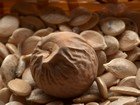
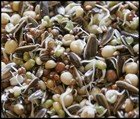
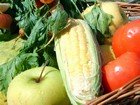
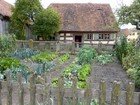
New! Comments
Do you have something of value to add? Leave me a comment in the box below.